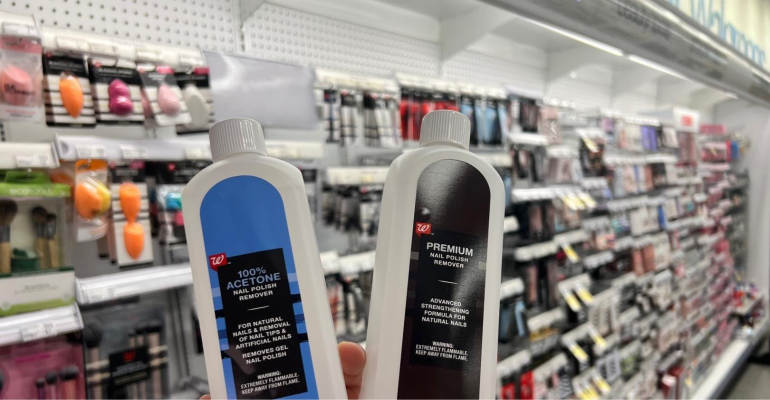In its previous ESG reports, Walgreens Boots Alliance had committed to four goals for its branded products by 2030: reduce plastic packaging by 30%, make all packaging recyclable, increase recycled content in packaging, and eliminate problematic single-use packaging.
So far, the retailer has made progress toward making all packaging recyclable, and part of that has come from an unexpected place — nail polish remover bottle caps.
“By switching from black plastic caps to white plastic caps in just these seven Walgreens brand products, we’re able to improve the recyclability of a projected 13 tons of plastic,” according to Andrew Horn, senior manager of sustainability operations. “Many recycling facilities use mechanical vision systems, essentially robots with cameras for eyes, to sort packaging that comes in. They have a difficult time correctly identifying black plastic. So, too often, they’ll put it in the waste stream or just inaccurately sort it into the wrong recycling stream.”
Black plastic is commonly used for packaging within the beauty and personal care products industry, the retailer said. Walgreens chose to shift its use of black plastic in beauty products, starting with its Walgreens brand nail polish remover packaging.
Dionne Carloni, Walgreens manager of packaging sciences, worked with product managers and suppliers to identify recyclable plastic options.
“We strive to eliminate carbon black plastic from Walgreens brand packaging whenever possible, even if that means deviating from comparable national brand packaging,” she said. “It’s a risk because we rely on colors to help our customers navigate to our products, but it's a change we’ve committed to in order to improve the recyclability of our packaging.”
Another area with growing success is eliminating the use of PVC plastic commonly seen in “blister packaging,” like the kind used in toothbrush packages with cardboard backs and plastic fronts.
“Recycling centers have an extremely difficult time recycling PVC, and most municipal facilities here in the U.S. don't handle it at all,” said Horn. “If we want to be 100% recyclable, we can't use PVC. We take a proactive approach with suppliers when discussing materials, and if they are proposing PVC, we tell them not to. PVC can often be replaced with a PET plastic that’s much more recyclable and is indistinguishable to customers.”
**
By switching from black to white plastic caps within seven of its health and beauty products, the retailer was able to improve the recyclability of a projected 13 tons of plastic. Have you found any quick fixes when it comes to ESG goals?
Let us know in the comments below, or email the SN staff at [email protected].





